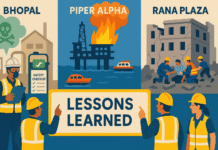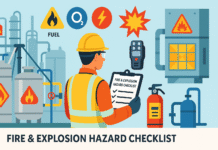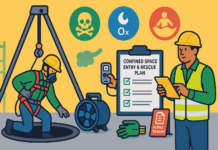
Concreting and Formwork HIRA (Hazard Identification and Risk Assessment)
Concreting and formwork are essential components in construction work, forming the backbone of structural stability. These tasks involve working with heavy materials, equipment, and chemicals such as cement, additives, and form oil. Hazards include collapsing formwork, concrete burns, manual handling injuries, equipment misuse, and falls from height.
A structured HIRA ensures that all potential hazards are identified, risks are assessed, and appropriate controls are implemented to protect workers during concreting and formwork operations.
Objective of Concreting and Formwork HIRA
- To identify hazards associated with concreting and formwork tasks.
- To assess the risks using a structured methodology.
- To implement suitable engineering, administrative, and PPE controls.
- To ensure safe practices and compliance with legal requirements.
Scope
This HIRA applies to all activities involving:
- Formwork erection and dismantling
- Mixing, pouring, and finishing concrete
- Use of concrete pumps and vibrators
- Manual handling of reinforcement and shuttering
- Curing and surface treatment of concrete
Step-by-Step HIRA for Concreting and Formwork
1. Activity Description
Concreting includes the mixing, transporting, placing, compacting, and finishing of concrete. Formwork involves the erection of temporary molds to hold concrete in shape until it sets and gains strength.
2. Hazard Identification Table
| S. No. | Hazard | Potential Effects | Persons at Risk |
|---|---|---|---|
| 1 | Collapse of formwork | Crush injuries, fatality | Workers in vicinity |
| 2 | Concrete splash or contact with skin | Chemical burns, irritation | Concreting crew |
| 3 | Fall from height during formwork or pouring | Fractures, head injuries, death | Form workers, pourers |
| 4 | Manual handling of materials | Back injury, strain | Laborers, masons |
| 5 | Rebar protrusion | Cuts, impalement | Workers at site |
| 6 | Vibrator mishandling | Hand-arm vibration syndrome | Concreting crew |
| 7 | Slip/trip on wet surface | Sprains, fractures | All site workers |
| 8 | Improper removal of formwork | Collapse, falling material | Formwork dismantlers |
| 9 | Electrical hazard from concrete vibrator | Shock, burns | Workers operating equipment |
| 10 | Exposure to dust from dry cement | Respiratory problems | Mixers, helpers |
3. Risk Assessment Matrix
Risk Rating = Likelihood (L) × Severity (S)
(Scale: 1–5 for both L and S)
| Hazard | Likelihood (L) | Severity (S) | Risk Rating | Risk Level |
|---|---|---|---|---|
| Collapse of formwork | 3 | 5 | 15 | High |
| Chemical burns from concrete | 3 | 4 | 12 | High |
| Fall from height | 4 | 5 | 20 | Critical |
| Manual handling injury | 3 | 3 | 9 | Medium |
| Rebar injuries | 3 | 3 | 9 | Medium |
| Vibrator-related injuries | 3 | 3 | 9 | Medium |
| Slips and trips | 4 | 2 | 8 | Medium |
| Improper formwork removal | 3 | 4 | 12 | High |
| Electrical shock | 2 | 5 | 10 | High |
| Cement dust inhalation | 3 | 3 | 9 | Medium |
4. Control Measures
Engineering Controls:
- Use of proper scaffolding and working platforms with guardrails during pouring.
- Use vibrators with anti-vibration handles and electrical safety features.
- Ensure formwork is designed by a qualified engineer and assembled as per design.
- Provide protective caps on rebar ends.
- Use mechanical mixers and cranes to minimize manual lifting.
Administrative Controls:
- Permit to Work (PTW) system for formwork erection and concrete pouring at height.
- Pre-activity briefing and Job Safety Analysis (JSA).
- Conduct daily inspection of erected formwork and shuttering.
- Maintain MSDS (Material Safety Data Sheet) for cement and additives.
- Clearly mark curing areas and barricade wet concrete zones.
Personal Protective Equipment (PPE):
- Long sleeve shirts and trousers to protect from concrete contact.
- Rubber gloves and boots for handling wet concrete.
- Safety helmet and reflective vest.
- Safety goggles or face shield for splash protection.
- Dust mask during mixing of dry cement.
5. Safe Work Procedure (SWP)
Before Starting Work:
- Verify approved formwork design drawings.
- Check stability and strength of ground/supporting base.
- Ensure availability of PPE and functioning of concrete equipment.
- Assign competent personnel for vibration and pouring operations.
- Barricade pouring area and restrict unauthorized access.
During Concreting:
- Maintain communication between pump operator and pourer.
- Use chute or pipeline to minimize manual transport.
- Compact concrete evenly using a mechanical vibrator.
- Maintain proper posture and avoid overreaching.
- Continuously clean the area of spillage to prevent slips.
During Formwork Removal:
- Follow the engineer’s instruction and approved schedule for stripping.
- Remove props and panels in reverse sequence of erection.
- Ensure no worker is beneath overhead removal activities.
- Dispose of used formwork material in designated zones.
6. Emergency Preparedness
- Keep fire extinguishers ready near curing and formwork zones.
- Emergency eye wash stations where chemical contact is possible.
- First aid kit to treat minor cuts, burns, or eye injuries.
- Emergency stretcher and evacuation plan for fall-related injuries.
- Clearly marked muster point and emergency contacts displayed.
7. Roles and Responsibilities
| Role | Responsibility |
|---|---|
| Site Engineer | Approve formwork design, ensure safe execution |
| Supervisor | Monitor daily activities and correct unsafe practices |
| HSE Officer | Conduct safety briefings, inspections, and enforce controls |
| Workers | Use PPE, follow procedures, and report hazards |
| Formwork Foreman | Oversee erection and dismantling per design |
| Concrete Operator | Operate pump, chute, and vibrators safely |
Summary of Key Recommendations
- Use only engineered formwork systems approved by a qualified person.
- Ensure all formwork and supports are inspected before concreting.
- Provide working platforms with guardrails for concreting at height.
- Ensure proper mixing, pouring, and compaction techniques are followed.
- Enforce PPE usage for all workers handling wet concrete or formwork.
- Implement safe dismantling procedures and schedule with supervision.
- Use rebar caps and maintain proper housekeeping to avoid slips and puncture hazards.
- Install warning signs and barricades around curing areas.
Monitoring and Review
- Conduct daily site safety walkdown for active concreting zones.
- Review HIRA weekly or after any formwork failure or near-miss.
- Record and investigate all incidents involving burns, slips, or formwork issues.
- Include regular safety drills for fall and collapse scenarios.
- Update HIRA if new additives, techniques, or equipment are introduced.
Conclusion
Concreting and formwork activities pose significant physical, chemical, and structural hazards. However, with a well-executed HIRA and strict adherence to safety protocols, the risks can be controlled effectively. Success depends on proper planning, competent supervision, quality equipment, and an informed workforce.
By proactively managing risks, we not only protect our workforce but also ensure high-quality, structurally sound construction.
Hot Work HIRA (Hazard Identification and Risk Assessment)
Scaffolding Work HIRA (Hazard Identification and Risk Assessment)
Working at Height HIRA (Hazard Identification and Risk Assessment)
Excavation Work HIRA (Hazard Identification and Risk Assessment)
What is a Job Safety Analysis (JSA)? Format, Benefits & Examples
























